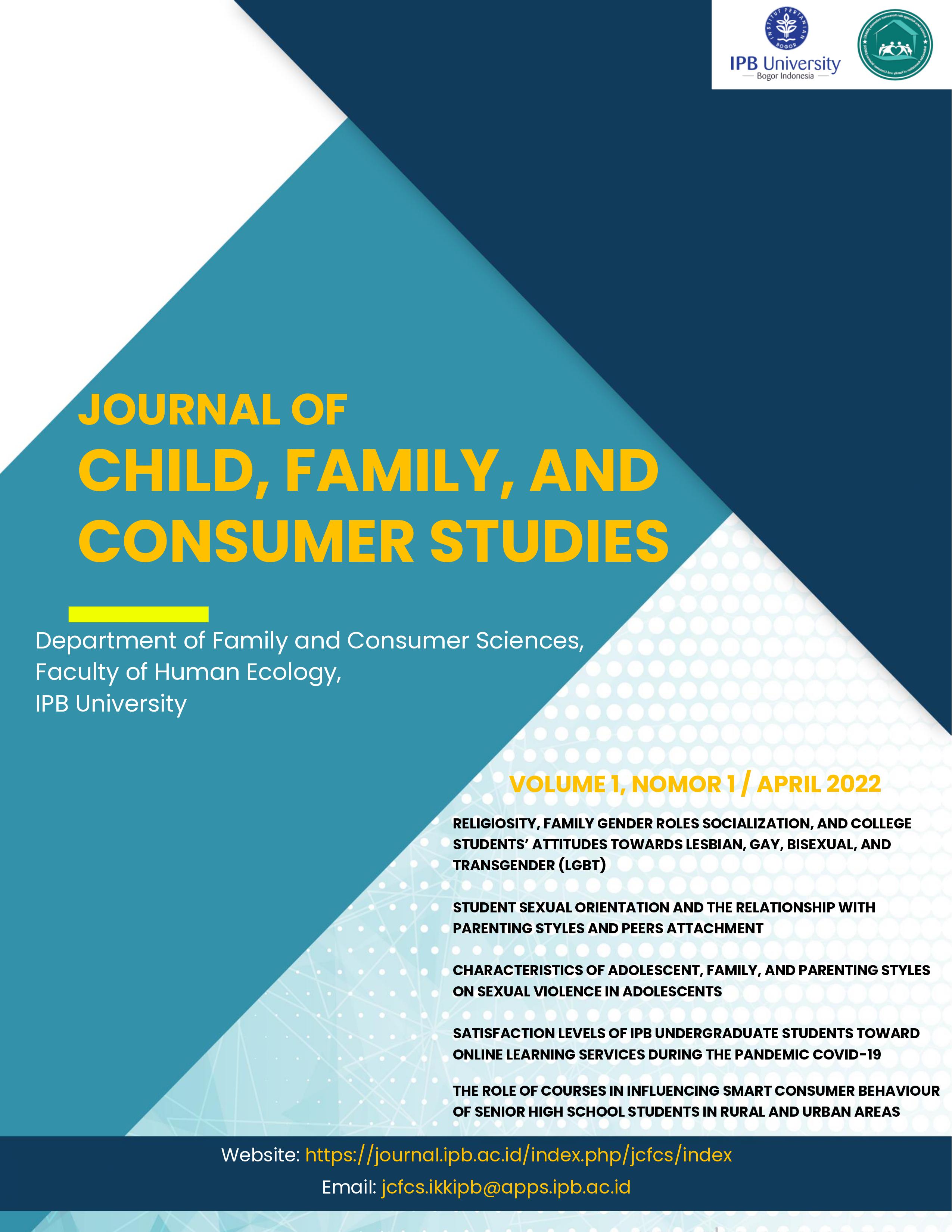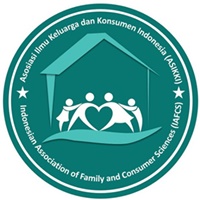CHARACTERISTICS OF ADOLESCENT, FAMILY, AND PARENTING STYLES ON SEXUAL VIOLENCE IN ADOLESCENTS
Abstract
Violence is a case that teenagers often experience, and violence cases in Indonesia are increasing every year. This study aims to analyze how adolescent and family characteristics and parenting styles influence sexual violence in adolescents. The research design used a cross-sectional study, followed by 45 young women who had experienced sexual violence in several provinces in Indonesia. The data collection technique used voluntary sampling using google-form, distributed through social media. This study uses the Parental Acceptance Rejection (PARQ) and Child Sexual Abuse (CSA). The results showed that adolescents who experienced violence were in the age range of 13 to 18 years. Teenage fathers primarily work as labourers, and mothers do not work/IRT. Parental marital status in general, living in their own home and residing in rural areas. The style of acceptance, aggression, neglect, and rejection of parents is low. However, sexual violence against adolescents is severe, with the most frequent perpetrators of violence perpetrated by their peers. The results showed that parents whose status was married had a rejection style of parenting, and teenagers who did not have their bedroom felt more cared for. Adolescents who live with nuclear families and receive an accepting parenting style from their parents are less likely to experience sexual violence.
Keywords: family characteristics, parenting style, sexual violence, teenagers
References
Anggreni, D., Notobroto, H. B., & Hargono, R. (2017). Relationship between Parental Parenting Patterns and Prevention of Sexual Violence in Children (Case Study in the Context of Preventing Sexual Violence in Children in Mojokerto City). Journal of Health Scientific Health Polytechnic Health Majapahit Mojokerto, 9(1), 1-9.
Aprilia, S. (2018). Quality of Parent-Child Interaction, School Environment and Diligent Character in Junior High School Students [Thesis]. Department of Family and Consumer Science, Faculty of Human Ecology, IPB. Accessed 2020 January 26 from https://repository.ipb.ac.id/handle/123456789/94887.
Asilah, A, & Hastuti, D. (2013). Relationship between Maternal Stress Levels and Parenting Acceptance of Rejection with Adolescent Self-Concept in Divorced Families. Journal of Family & Consumer Science, 7(1), 10-18. Doi:10.24156/jikk.2014.7.1.10
Azizah, M., Hubeis, A.V.S., Wibowo, C.T. (2017). Family Communication Patterns of Women Night Workers on Child Care (Case Study: Female Employees at Class II A Women's Prisons in Bandarlampung). KMP Journal (Journal of Development Communication), 15(1), 107-122. Doi:10.29244/jurnalkmp.15.1.%p.
Cahyani, Y. N., Verdiantoro, A. G., & Uma, F. (2020). Legal Protection for Victims of Sexual Violence of the Deaf in the Perspective of Criminal Law. The Pulpit of Justice, 13(2), 218-228.
David, F. (1997). C t – s, a, w. Childhood and Trauma Separation, Abuse, War, 244.
Dewi, N.M.T., Dewi, A.M.A.T., & Dewi, N. L. S. M. (2020). Legal Consequences of Prostitution Perpetrated by Minors. Journal of Citizenship Education Undiksha, 8(3), 181-195. Doi:10.23887/jpku.v8i3.28666.
Fitriana, Y., Pratiwi, K., & Sutanto, A. V. (2015). Factors related to the behavior of parents in committing verbal violence against pre-school age children. Journal of Psychology Undip, 14(1), 81-93.
Fu'ady, M. A. (2011). Psychological Dynamics of Sexual Violence A Phenomenological Study. Psychoislamika: Journal of Psychology and Islamic Psychology, 8(2), 191-208. Doi:10.18860/psi.v0i0.1553.
Handayani, M. (2017). Prevention of cases of sexual violence against children through interpersonal communication between parents and children. Scientific Journal of Vision, 12(1), 67-80.
Harmadi, M., & Diana, R. (2020). A Psycho-Theological Review of the Phenomenon of Dating Violence in Adolescents. Evangelicals: Journal of Evangelical Theology and Community Development, 4(1), 92-102.
Hartoyo, H. D. (2004). Investment behavior in children of fishermen's families and its implications for poverty alleviation. Bogor: Faculty of Human Ecology, Bogor Agricultural University.
Hasanah, U., & Raharjo, S. T. (2016). Handling Community-Based Child Violence. Share Soc. Work J.6(1). Doi:10.24198/share.v6i1.13150.
Hastuti, D. (2015). Parenting: Theories and principles and their application in Indonesia. Bogor: IPB Science Techno Park.
Ligina, N. L., Mardhiyah, A., & Nurhidayah, I. (2018). The Role of Parents in the Prevention of Sexual Violence in Elementary School Children in the City of Bandung. Ejournal Umm, 9(2), 109-118.
Mohler-Kuo, M., Landolt, MA., Maier, T., Meidert, U., Schönbucher, V., & Schnyder, U. 2014. Child sexual abuse revisited: A population-based cross-sectional study among swiss adolescents . Journal of Adolescent Health, 54(3), 304-311. Doi: 10.1016/j.jadohealth.2013.08.020.
Murray, L. K., Nguyen, A. & Cohen, J. A. (2014). Child Sexual Abuse. Child Adolescence. psychiatrist. Clin. N. Am. 23(2), 321–337. Doi: 10.1016/j.chc.2014.01.003.
Noviana Pi. 2015. Sexual violence against children: its impact and treatment. Socio Informa, 1(1), 13–28. Doi: 10.33007/inf.v1i1.87.
Purwanti, A., & Hardiyanti, M. (2018). Strategy for the Resolution of Sexual Violence Against Women and Children Through the Sexual Violence Bill. Legal Matters, 47(2), 138-148.
Ramadhani, P. E., & Krisnani, H. (2019). Analysis of the Impact of Parental Divorce on Adolescents. Focus J. Pekerj. Sos.2(1), 109. Doi: 10.24198/focus.v2i1.23126.
Rohner, R. P., Khaleque, A., & Cournoyer, D. E. (2005). Parental acceptance‐rejection: Theory, methods, cross‐cultural evidence, and implications. Ethos, 33(3), 299-334. Doi:10.1525/eth.2005.33.3.299.
Setiani, F.T., Handayani, S., & Warsiti. (2017). Phenomenological Study of Factors Affecting the Occurrence of Sexual Violence in Girls in Wonosobo Regency. J. PPKM 4(2), 122–128. Doi: 10.32699/ppkm.v4i2.414.
Sigalingging, G., & Sianturi, I. A. (2019). Relationship between peers and adolescent sexual behavior at SMK Medan, Medan Sunggal area. Journal of Darma Agung Husada, 5(1), 9-15.
[SIMFONI PPA] Online Information System for the Protection of Women and Children. (2020). National violence data. Retrieved from https://kerasan.kemenpppa.go.id/ringkasan.
Sulastri, S., & Nurhayaty, A. (2021). Psychological Dynamics of Girls Victims of Incest Sexual Violence: A Case Study. PSYCHE Journal Psychology, 3(1), 94–109. Doi:10.36269/psyche.v3i1.340.
Suyanto, B. (2013). Child trafficking and the global sex industry. Global & Strategic, 7(1), 139-154.
Voluntir, F. & Alfiasari. (2014). Parental Acceptance Determines the Parenting Environment of Families With Adolescents In Suburban Areas. Journal Character Education, 5(3), 294–306. Doi: 10.21831/jpk.v0i3.5634.
Wardana, D.J., & Roqib, M. (2021). The Role of Students in Strengthening the Enforcement of Permendikbudristek Number 30 of 2021 concerning Prevention and Handling of Violence in the Student Villages of Bojonegoro Regency. Borobudur Journal on Legal Services, 2(2), 75-81.










